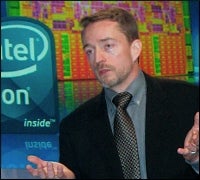 Pat Gelsinger, general manager of Intel’s Digital Enterprise Group. Click to enlarge. Photo: David Needle |
SANTA CLARA, Calif. — Even with partners IBM and Sun in the audience, Intel exec Pat Gelsinger couldn’t help himself. In comparing the performance of Intel’s new Xeon 5500 “Nehalem” processors to Sun SPARC and IBM’s Power 6 chips, Gelsinger didn’t mince words.
“We’re less than half the cost and 1.7 times the performance of SPARC,” Gelsinger said. “Versus IBM, it’s almost humorous. We’re one-tenth the cost and up to 2.45 times the performance.”
As it turns out, both companies are bringing out systems based on the new Xeons, and were on hand here at Intel headquarters, as the world’s largest chipmaker and its key partners gathered for the official launch of the processor line.
But Intel’s making it clear that this isn’t just any product launch, and that Nehalem isn’t just any new processor. The company said Nehalem has broken over 30 benchmarks for two-socket performance and offers twice the performance of the earlier Xeon 5400 series. Other key features include power management that offers a 50 percent reduction in a system’s idle power requirement versus the 5400 and an enhancement called Turbo Boost, which maximizes performance when all cores aren’t being used.
Nehalem’s formal debut here today has been one of the tech world’s most poorly kept secrets. Intel (NASDAQ: INTC) had long detailed its plans for Nehalem on its product road map, but today, its major server partners, including Dell, HP, IBM, Sun and newcomer Cisco, joined the chip giant in showing off their product plans which ranged from workstations, to blades and servers.
Gelsinger, senior vice president and general manager of Intel’s Digital Enterprise Group, also said Intel actually started shipping the first Nehalem units back in December, and “several hundred thousand” systems based on the new quad-core processor have already gone out.
Still, even with the lousy economy, Gelsinger said server sales are doing well. “The downturn is the downturn, but relatively speaking, servers are a healthier business,” he said. “We continue to see strength in some segments, and overall, it’s a bit healthier than the rest of the unhealthy business.”
While the downturn has hit industries like e-commerce, entertainment and healthcare, IT executives from each sector were also on hand to validate Intel’s claims that businesses would buy Nehalem servers to get more cost-effective power out of their datacenters.
“To some extent, animated movie production is like scientific computing meets eBay,” joked Lincoln Wallen, head of research and development at DreamWorks, who spoke during a customer panel after Gelsinger’s presentation. “Digital artist are always looking to do more on the screen, and that typically means a very heavy compute cost. We see Nehalem playing a significant role in providing more compute power per watt and a greater memory subsystem,” he said.
Paul Ratner, vice president of IT operations at healthcare provider Humana, said the timing of the Nehalem release couldn’t have been better. He said his company has over 10 million customers and the amount of data it has to process has increased ten times over the past three years.
One of its datacenters, in fact, had essentially grown as much as it could using existing technology.
[cob:Special_Report]
“There was no more square footage and we ran out of energy,” he said.
Learning from those lessons, a new datacenter in the works will leverage Nehalem-based blade servers.
“We’re going from three to 42 percent blades, which is going to reduce the physical footprint by half [and] require a lot less electricity and cooling,” he added. “Virtualization is also a very big deal to us.”


